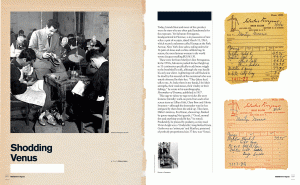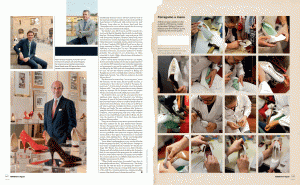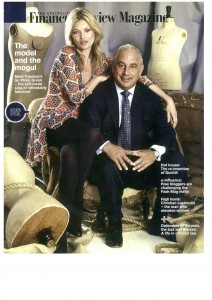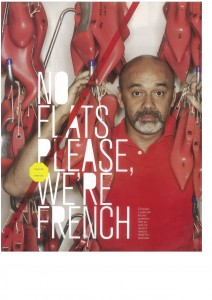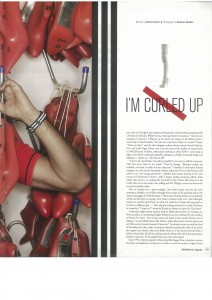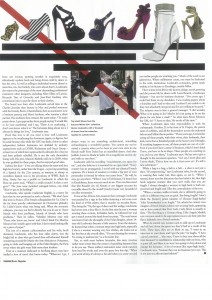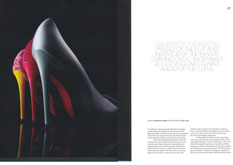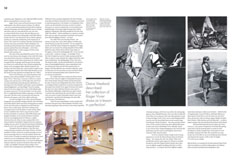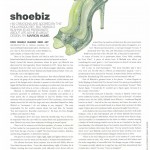Shodding Venus
When it comes to celebrity endorsement, you can’t top Marilyn Monroe. The story behind master shoemaker Salvatore Ferragamo, his muses and the legacy.
The Australian Financial Review Magazine | August 2012
by Marion Hume
Today, brands bleat and tweet of free product worn by stars who are often paid handsomely for the exposure. Yet Salvatore Ferragamo, headquartered in Florence, is in possession of rare relics: a pair of receipts, dated March 11, 1961, which record a salesman called George at the Park Avenue, New York shoe salon, taking orders for 16 pairs of shoes and a white calfskin bag. In return, the most famous woman in the world wrote cheques totalling $US563.30.
These were far from Marilyn’s first Ferragamos. In the 1950s, Salvatore pushed his heel height up to 11 centimetres specifically to add more wiggle to the bombshell’s walk, although she was hardly his only star client. A glittering role call flocked to be shod by this messiah of the metatarsal who was utterly obsessed by their feet. “They [these feet] talk to me. As I take them in my hands, I feel their strengths, their weaknesses, their vitality or their failings,” he wrote in his autobiography, Shoemaker of Dreams, published in 1957.
This rags-to-riches-to-rags-to-riches life story features (literally) walk-on parts from such silver screen icons as Lillian Gish, Clara Bow and Gloria Swanson – although the shoemaker was far less intrigued by them from the ankle up. Then later, Hitler’s mistress, Eva Braun, showed up, flanked by goose-stepping Nazi guards. (“Good, normal feet and anything would fit her,” he noted). Predictably, he praised by podiatry, so tiny-toed Vivien Leigh was a ‘Cinderella’, longlimbed Greta Garbo was an ‘aristocrat’ and Marilyn, possessed of perfectly proportioned size 37 feet, was ‘Venus’.
It is 50 years since the avatar of the American dream died. Yet a master craftsman called Stefano Frasconi is holding a pump in soft white lambskin, a near replica of the one Marilyn ordered many times – in white, nude, black, gold. As Frasconi holds a shoe that is yet to meet its heel, he is struggling to explain – through a translator and a mouthful of nails – what makes it special. But just like the company founder, any celebrity connection seems to be a sideline to him. Instead, Frasconi repeats “calzata perfectamente” (perfect fit), emphasising with sharp taps of a little hammer. He keeps pulling at the leather, pre-soaked for days to provide flexibility, then jumps up and puts the shoe in a customised oven, before stretching its leather upper again and banging it with the hammer.
In close-up, this scene, playing out at the Ferragamo atelier on the outskirts of Florence, may seem somewhat anachronistic: the shoemaker hunched over a low bench spread with tools not dissimilar to those Salvatore himself might have used when he started making shoes commercially in 1906, aged 13. (He had made his first shoes, for his sisters, when he was only nine). But luddite practices, however charming, don’t account for a company that is listed on the Milan stock exchange and has 593 stores worldwide. The organisation posted total revenues for the first quarter of 2012 of €259.6 million ($305.5 million). WHile skills of human eye and hand helped, state-of-the-art machines aided the production of hundreds of thousands of pairs of shoes, as well as clothing, luggage, small leather goods, eyewear, scarves, ties, timepieces, fragrance and handbags, made elsewhere in Italy.
Widening the focus reveals our location to be a vast, slick, industrial set-up known as Manovia, after the Italian word for circular ‘rail’ system, which here moves shoes from one production process to the next. Yet this, too, traces directly back to the founder, whose experiment with a mechanised production line that would still preserve the exacting standards of custom-made shoes was so ahead of its time, it lead to his 1933 bankruptcy.
Salvatore certainly bounded back. By the 1940s, the peasant boy from a family that had struggles for survival on a small holding was the proud owner both if Il Palagio, a sumptuous hillside villa outside FLorence that is still a family home, and a castle, complete with ramparts, right in the heart of the renaissance city. Palazzo Feroni remains the company’s headquarters. When Salvatore died suddenly in 1960, he left a much younger wife, Wanda, six children and a truly international business. Since then, it is the 90-year-old matriarch, ‘Mrs Wanada’, who still turns up for work every morning and who has preserved his legacy.
To avoid confusion, it is Ferragamo company policy to call family members by their first name, preceded by ‘Mr’ or ‘Mrs’. Hence the 67-year-old Ferruccio, who is chairman of the company, is dubbed Mr Ferruccio. His siblings – Mrs Giovanna, Mrs Fulvia, Mr Leonardo and Mr Massimo – all have key roles. (The eldest daughter, Fiamma, who designed the best-selling flat Vara pump with its gold plaque and grosgrain ribbon, dies in 1998).
Given there are 60 direct heirs, not only is there no room at the family firm for them all but a wise and stringent charter decrees that only the top three from each subsequent generation are welcome. The most visible of the third generation,in part because of his matinee idol looks, is 40-year-old Mr James, who is women’s leather product director. The first of the fourth generation to hit 21, Lorenza Gentile, has not yet fulfilled the minimum requirements even to apply: an MBA and several years experience work elsewhere.
When Mr Ferruccio sits down to chat over a rocket-fuel espresso at the palazzo, he says that what locks everything together is “quality products that are good value for what they are; with innovation, long-lasting”. This sounds much like many other brands, but he adds that the difference is: “We don’t want to ever overcome the personality of the customer.” Evidence can be found directly below us, in the mirrored shoe salon at street level. The Viatica is a timeless two-tone stiletto of white suede and black calf. That Marilyn Monroe’s ‘Sugar’ Kane Kowalczyk wore this exact style to woo her Shell Oil millionaire in Some Like it Hot starts to matter note more but, strangely, less, once these lovely shoes are beckoning one’s own feet. Which is to say, you yearn for them to be yours, not hers.
What lies beneath remains the same, then and now. The soul of Ferragamo – pun intended- is the sole. The founder- who lied in Italy, then America, then returned to Italy – was studying anatomy at night school in Los Angeles just as architects on Americana’s east coast were realising that they could build skyscrapers taller with less load-bearing structure at the base. Similarly, Salvatore surmised that, as the weight of the erect human body is borne not by toes or heels but drops straight down on the arch, a revolutionary steel arch support would act with the equilibrium of the body in motion instead of fighting against it. This slim plate remains central to comfort. No wonder that (whisper it) both the queen of the red carpet, Angelina Jolie, and the queen of all she surveys, HRH Elizabeth II, are believed to be loyal, paying customers.
That Ferragamo also offers a wide range of fittings (A to D, others on special order) has helped gather fans in the brand’s most robust market, China. There widths C and D are hte most common, which has ripped up other luxury shoemakers offering styles of a narrow French foot and who may also have faced an additional anatomical barrier: purveyors of very high-heeled ‘limo shoes’ find these cannot adapt to the average length of the chinese foot without the wearer being en point like a ballerina. That said, Chinese movie star, Fan Bingbing does favour towering Ferragamos. THese are custom-made, their height achieved with extraordinary platforms. As for Australian feet, Salvatore has this to say about them when he visited Sydney in 1958: “Nature has been generous in length though they, too, are narrow.”
The Asia Pacific region is the group’s top market in terms of revenue, up 27.3 per cent with a turnover of 96.4million for the first quarter of 2012. A further reason is menswear, attractive to a market where men tend to embrace luxury goods before they treat their wives. For Salvatore Ferragamo himself it was making books for men that led to his breakthrough American success. Salvatore made his mark in the American motion picture industry, before i relocated from Santa Barbara to Hollywood, with cowboy boots for early Westerns. From then on, he always shod male feet. (“Mussolini lost his corns and bad toenails after he wore my boots,” is just one comment n the subject).
The founder’s sons, Mr Ferruccio and Mr Leonardo, first stood on the Bund in Shanghao when they past was mud their feet. The brand debuted with a store in the city in 1994 (with local partner, Imaginex). Hermès, Chanel, Prada, Gucci are between two and six times bigger than Ferragamo, yet in China this pioneer consistently marches ahead and is present in 34 cities. Company CEO Michele Norsa has no fears of brand saturation in China. “Not at all, we worked with McKinsey on a fiveyear plan,” he says. “We imagine in the next three to five years, we can cover another 10 to 20 cities probably. The potential of new destinations in China connected by trains, flights, infrastructure development is becoming very substantial.”
Norsa – known by his surname because he is an outsider, the first non-family member to hold a keymanagerial position – was hired in 2007, primarily to put in place the organisation and governance to gear up the company for an IPO, which was delayed by the 2008 crash and accomplished successfully last year. He says that Chinese customers in Beijing and Shanghaimay travel to avoid high duties and taxes,which has helped make Australia “one of the best markets in the world this year for us”.
The shoesmust bemade in Italy, “one of our pluses”, insists Mr Ferruccio, “for the name, the best quality and also, as commitment to those who have worked at Ferragamo for many years.” As to his nation’s economic woes, the company chairman adds: “I am sorry because there are many elements which are uncertain. We are fortunate because we produce 100 per cent in Italy, butwe sell, I think, 9 per cent in Italy.”
The founder’s three sons and the next generation have significant other interests. Mr Ferruccio’s son Salvatore Ferragamo II, twin of Mr James, helms their father’s parallel hotel and wine business, based in a medieval hamlet about 45 minutes’ drive from Florence. Closer to Siena is an 800year old winery and hotel, Castiglion del Bosco, owned by Mr Massimo and family. The most ambitious other business is surely Mr Leonardo’s.He is chairman and owner of Lungarno Collection, a luxury hotel group, with seven of the swankiest places to stay around Florence and another in Rome. He also owns the majority of Nautor’s Swan, the largest global producer of luxury yachts.
Today, the core business is ring-fenced against hostile threats like those endured by the part family-owned Hermès. Salvatore Ferragamo SpA is ripe for further growth (Norsa cites Jakarta and Berlin as examples) and a dynasty’s long view means thatMr James has been able to continue the inventiveness of a grandfather who tried sweet wrappers, fishing wire and tree bark as shoe uppers. He innovates in a sustainable context, while admitting that a 100 per cent biodegradable handbag (nometal parts) has yet to find broad appeal.
“In my father’s autobiography, in a way you can tell he felt his life was going to be short,” says Mr Ferruccio. “Perhaps we have tried to accomplish what he wanted to do”. But let’s not forget Mrs Wanda, born just four years before Marilyn Monroe and still standing ramrod straight in her Ferragamo heels. It is the matriarch who greets guests for cocktails after they have visited Museo Salvatore Ferragamo, housed within the cavernous palazzo for an exhibition dedicated to the icon (Marilyn runs to January 28, 2013).
“When Daddy passed away, [my mother] knew how to make children but not shoes,”Mr Ferruccio says. “Yet she has lived her life with the desire of continuing the business”.
Indeed, Mrs Wanda, long ago a teenage bride, deserves much of the credit for a sometimes glamorous, sometimes gruelling journey of this brand born of a fascination with feet.

